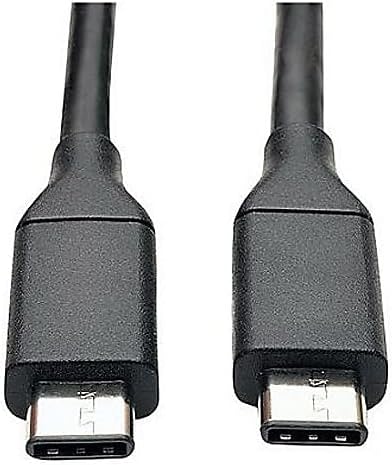USB 3.1 Gen 2 offers impressive speed improvements over earlier USB standards. It can transfer data at up to 10 Gbps, which is twice as fast as USB 3.0 (also called USB 3.1 Gen 1). And now it has a new name: USB 3.2 Gen 2×1.
This higher bandwidth allows users to transfer large files like 4K videos or backup drives in significantly less time, making it ideal for professionals who work with data-intensive applications.
The technology uses the same connectors as previous versions but often comes with teal-colored ports to help users identify them. Many new devices like external SSDs, video capture cards, and high-resolution monitors take advantage of USB 3.1 Gen 2’s faster speeds. Despite the confusing naming conventions (it’s sometimes called USB 3.2 Gen 2), the standard maintains backward compatibility with older USB devices.
What Is USB 3.1 Gen 2?
USB 3.1 Gen 2 is a high-speed data transfer standard capable of delivering speeds up to 10 Gbps (gigabits per second). First introduced in 2013, it doubled the performance of USB 3.0 (now retroactively called USB 3.1 Gen 1), enabling faster file transfers, reduced latency, and better support for high-resolution peripherals like 4K monitors, external SSDs, and high-bandwidth USB hubs.
This version of USB also brought support for USB Power Delivery (USB-PD), allowing up to 100W of power, which made it viable for charging larger devices like laptops through a single USB-C cable.
USB 3.1 Gen 2 vs Other USB Versions
To help make sense of USB naming confusion, here’s how USB 3.1 Gen 2 compares to other standards:
| USB Version | Max Speed | Connector Types | Released | Also Known As |
|---|---|---|---|---|
| USB 2.0 | 480 Mbps | Type-A, Micro-USB | 2000 | High-Speed USB |
| USB 3.0 / 3.1 Gen 1 | 5 Gbps | Type-A, Micro-B, Type-C | 2008 | SuperSpeed USB |
| USB 3.1 Gen 2 | 10 Gbps | Type-A, Type-C | 2013 | SuperSpeed+ USB |
| USB 3.2 Gen 2×2 | 20 Gbps | Type-C only | 2017 | SuperSpeed+ 20Gbps |
| USB4 | 40 Gbps | Type-C only | 2019 | Based on Thunderbolt 3 |
As the table shows, USB 3.1 Gen 2 represented a sweet spot for speed, compatibility, and power delivery, especially when it was first released. It remains widely used even with USB4 on the horizon.
Key Benefits of USB 3.1 Gen 2
USB 3.1 Gen 2 isn’t just about higher speeds—it also introduced several critical technical and usability improvements:
1. Faster Transfers
- Up to 10 Gbps (about 1.25 GB/s) — enough to handle 4K video streams, external NVMe SSDs, or heavy data transfers without bottlenecks.
2. Improved Encoding
- USB 3.1 Gen 2 uses 128b/132b encoding, which is far more efficient than the 8b/10b encoding used in earlier USB 3.0/3.1 Gen 1. This results in less data overhead and higher net transfer rates.
3. Backward Compatibility
- Fully compatible with USB 3.0 and USB 2.0 devices—so you can plug in older devices without worrying about incompatibility.
4. USB-C Support
- While USB 3.1 Gen 2 works with both USB-A and USB-C connectors, it is most commonly paired with USB-C, which is reversible and allows for better power delivery and multi-function use (charging + data + video).
Where You’ll Find USB 3.1 Gen 2 Today
Although newer specs like USB 3.2 and USB4 exist, USB 3.1 Gen 2 is still extremely relevant and widely used, particularly in:
- External SSDs (Samsung T5, SanDisk Extreme Portable)
- High-end USB flash drives
- Gaming peripherals like capture cards or VR headsets
- Docking stations and hubs with USB-C passthrough
- Laptops and desktops with USB-C ports (especially from 2017–2022)
Here’s a look at common devices and their USB versions:
| Device Category | Typical USB Version | Why It Matters |
|---|---|---|
| External SSDs | USB 3.1 Gen 2 | Enables max read/write speeds |
| Capture Cards | USB 3.1 Gen 2 / Gen 1 | High bandwidth needed for 1080p/4K input |
| Docking Stations | USB 3.1 Gen 2 / USB 3.2 | Charging + DisplayPort + USB passthrough |
| VR Headsets (e.g., Quest Link) | USB 3.1 Gen 2 | Low latency and stable high-data connection |
Naming Confusion: Why USB 3.1 Gen 2 Isn’t Called That Anymore
The USB-IF (USB Implementers Forum) updated naming conventions to make things more “consumer friendly,” though many would argue it just added confusion.
Here’s a breakdown:
- USB 3.1 Gen 2 is now part of USB 3.2 Gen 2×1
- USB 3.2 Gen 2×2 is the newer 20 Gbps standard
So depending on your device or spec sheet, you might see USB 3.1 Gen 2 referred to as:
- USB 3.2 Gen 2
- USB 3.2 Gen 2×1
- SuperSpeed USB 10Gbps
It’s all the same under the hood: 10 Gbps maximum throughput on a single data lane.
Do You Need USB 3.1 Gen 2?
Here’s a quick guide:
| Task | USB 3.0 (5 Gbps) | USB 3.1 Gen 2 (10 Gbps) | USB 3.2/USB4 (20–40 Gbps) |
|---|---|---|---|
| Transferring large files | ✅ Okay | ✅✅ Much faster | ✅✅✅ Best |
| External 4K video capture | ⚠️ Bottleneck | ✅ Capable | ✅✅ Smoother |
| Gaming accessories | ✅ Supported | ✅ Faster setup | ✅✅ Low latency |
| Fast charging laptops (USB-C) | ⚠️ Limited watts | ✅ Up to 100W (with PD) | ✅✅✅ More efficient |
| Connecting high-res displays | ⚠️ Limited | ✅ 4K @ 60Hz possible | ✅✅ 8K & dual displays |
In short: if your workflow involves large files, video streaming, or high-power USB-C devices, USB 3.1 Gen 2 is still a solid choice—even in 2025.
Key Takeaways
- USB 3.1 Gen 2 delivers 10 Gbps data transfer speeds, twice as fast as USB 3.1 Gen 1/USB 3.0.
- The technology supports 4K video at 60Hz and provides power delivery up to 100W for compatible devices.
- Despite various naming conventions, USB 3.1 Gen 2 ports are typically teal-colored and remain backward compatible with older USB devices.
Understanding USB 3.1 Gen 2 Technology
USB 3.1 Gen 2 represents a significant leap in data transfer capabilities, offering speeds up to 10 Gbps while maintaining backward compatibility with older USB standards. This technology provides enhanced power delivery and supports a variety of connector types to meet modern computing needs.
Evolution of USB Standards
USB technology has undergone several generations of improvements since its introduction. USB 2.0, released in 2000, offered speeds up to 480 Mbps and became the standard for many years.
In 2010, USB 3.0 arrived with speeds up to 5 Gbps, later renamed to USB 3.1 Gen 1. This renaming has caused some confusion in the market.
USB 3.1 Gen 2 emerged in 2013, doubling the transfer speed to 10 Gbps. This standard is also known as “SuperSpeed+” or “SuperSpeed USB 10 Gbps.”
The naming convention changed again with USB 3.2, where USB 3.1 Gen 2 became USB 3.2 Gen 2. Later, USB4 was introduced with even higher speeds and enhanced capabilities.
Technical Specifications
USB 3.1 Gen 2 delivers impressive performance improvements over previous generations:
- Data Transfer Speed: Up to 10 Gbps (double the speed of USB 3.1 Gen 1)
- Power Delivery: Support for USB PD up to 100W (with compatible hardware)
- Encoding: 128b/132b encoding (more efficient than previous 8b/10b)
- Backward Compatibility: Works with USB 3.0, 2.0, and 1.1 devices
The high bandwidth capabilities make USB 3.1 Gen 2 ideal for external SSDs, video capture devices, and docking stations. The improved power delivery specifications allow for quick charging of laptops and other high-power devices.
USB 3.1 Gen 2 also reduces latency compared to previous generations, offering more responsive connections for peripherals like external GPUs.
Connector Types
USB 3.1 Gen 2 supports multiple connector types, giving users flexibility in device connections:
USB Type-A: The traditional rectangular connector found on computers for decades. USB 3.1 Gen 2 Type-A ports are often colored blue or red.
USB Type-B: Mainly used for printers and scanners, with a larger form factor for USB 3.1 Gen 2 compared to USB 2.0.
USB Type-C: The newest and most versatile connector. Type-C is reversible, compact, and supports all USB 3.1 Gen 2 features including the full 10 Gbps speed and enhanced power delivery.
Micro and Mini connectors also exist but are less common with USB 3.1 Gen 2 devices. The USB Type-C connector has become increasingly popular due to its versatility and is now the preferred connector for USB 3.1 Gen 2 implementations.
Applications and Use Cases
USB 3.1 Gen 2 technology offers significant advantages for various activities requiring high-speed data transfer and efficient power delivery. Its 10Gbps transfer rate makes it ideal for demanding tasks across multiple environments.
Charging Capabilities
USB 3.1 Gen 2 delivers impressive charging power for modern devices. It supports the USB Power Delivery specification, allowing for up to 100W power transfer.
This capability means faster charging times for laptops and other high-power devices. Many laptops can reach 50% battery in just 30 minutes using this technology.
The bidirectional power flow is another advantage. Devices can both send and receive power through the same connection, creating more flexible setups.
For mobile professionals, this means carrying fewer chargers. A single USB 3.1 Gen 2 cable can charge a laptop, phone, and tablet with appropriate power for each device.
Enhancing Productivity
Content creators benefit significantly from USB 3.1 Gen 2’s high-speed data transfer. Video editors can move 4K footage between external drives at nearly 1.25GB per second.
The technology supports multiple 4K displays through DisplayPort Alt Mode, allowing professionals to create expansive workstations. DSC (Display Stream Compression) maintains high image quality even at these resolutions.
Large file transfers that once took hours now complete in minutes. This efficiency is crucial for photographers backing up RAW image libraries or architects working with detailed 3D models.
For office setups, a single USB 3.1 Gen 2 dock can connect multiple peripherals including high-resolution monitors, storage devices, and network adapters without sacrificing performance.
Gaming and Entertainment
Gamers experience notable improvements with USB 3.1 Gen 2 connectivity. External GPUs connect with minimal latency, turning standard laptops into gaming machines.
High-speed external SSDs load games almost as quickly as internal drives. This eliminates the traditional performance penalty of external storage for gaming applications.
Virtual Reality headsets benefit from the increased bandwidth. The technology supports high-resolution displays with faster refresh rates needed for immersive experiences.
For streamers, USB 3.1 Gen 2 enables simultaneous 4K video capture and streaming without frame drops. External capture cards process game footage without the lag that plagued earlier USB standards.
Console gamers can expand storage capacity without compromising load times. The 10Gbps throughput minimizes waiting when launching resource-intensive titles from external drives.
Compatibility and Integration
USB 3.1 Gen 2 connects with various devices and technologies while maintaining backward compatibility. This makes it versatile for both modern and older equipment.
Cross-Device Compatibility
USB 3.1 Gen 2 works seamlessly with older USB standards. When connecting to USB 3.0 or USB 2.0 ports, devices will function normally but at the lower speed of the older port.
This backward compatibility ensures users don’t need to replace all existing peripherals when upgrading to newer technology. A USB 3.1 Gen 2 external drive will work in a USB 2.0 port, just at USB 2.0 speeds.
Most connectors maintain compatibility across generations. However, USB-B 3.1 cables won’t work with USB-B 2.0 ports due to physical differences in the connectors.
The cross-compatibility extends to various device types including:
- Storage devices
- Input peripherals (keyboards, mice)
- Audio equipment
- Docking stations
Display and Video Options
USB 3.1 Gen 2 supports multiple display standards, enhancing flexibility for monitors and video devices. The 10 Gbps bandwidth allows for high-resolution video transmission.
Many USB 3.1 Gen 2 ports support Alternate Mode, which enables DisplayPort or HDMI signals to travel through the USB cable. This allows direct connection to monitors without additional adapters in many cases.
Thunderbolt 3 technology often uses the same USB-C connector as USB 3.1 Gen 2. While they’re physically identical, Thunderbolt 3 offers more bandwidth (40 Gbps) and features.
Display options through USB 3.1 Gen 2 include:
- Single 4K display at 60Hz
- Dual HD displays with proper adapters
- Video capture devices requiring high bandwidth
The technology supports daisy-chaining multiple displays when paired with compatible hardware and DisplayPort functionality.
Frequently Asked Questions
USB 3.1 Gen 2 offers significant improvements in data transfer speeds and connectivity options. Many users have common questions about its capabilities and how it compares to other USB standards.
What is the maximum data transfer speed of USB 3.1 Gen 2?
USB 3.1 Gen 2 provides a maximum data transfer speed of 10 gigabits per second (Gbps). This theoretical burst transfer rate is double the speed of its predecessor.
The increased bandwidth allows for faster file transfers and improved performance when using external devices such as hard drives and SSDs.
How does USB 3.1 Gen 2 compare to USB 3.2 Gen 2 in terms of performance?
USB 3.1 Gen 2 and USB 3.2 Gen 2 have identical performance characteristics, both offering 10 Gbps transfer speeds. The difference is primarily in naming convention rather than technical capabilities.
The USB-IF (USB Implementers Forum) renamed USB 3.1 Gen 2 to USB 3.2 Gen 2 as part of their standardization efforts, causing some confusion among consumers.
Can devices with USB 3.1 Gen 2 connectors operate at the same speed as USB 3.2 Gen 2?
Yes, devices with USB 3.1 Gen 2 connectors can operate at the same 10 Gbps speed as USB 3.2 Gen 2 devices. The standards are technically equivalent despite the different names.
For full speed benefits, all components in the connection chain (host, cable, and device) must support the USB 3.1 Gen 2 standard.
What are the main differences between USB 3.2 Gen 1 and USB 3.2 Gen 2?
The main difference between USB 3.2 Gen 1 and USB 3.2 Gen 2 is the maximum data transfer speed. USB 3.2 Gen 1 (previously USB 3.0 and USB 3.1 Gen 1) supports speeds up to 5 Gbps.
USB 3.2 Gen 2 offers twice the bandwidth at 10 Gbps. Both standards are backward compatible with older USB devices.
How does USB 3.1 Gen 2’s speed compare to USB 3.1 Gen 1?
USB 3.1 Gen 2 delivers twice the speed of USB 3.1 Gen 1. Gen 2 supports up to 10 Gbps, while Gen 1 (originally USB 3.0) tops out at 5 Gbps.
This speed difference is significant when transferring large files or working with high-bandwidth devices like external SSDs or video capture equipment.
What connectivity benefits are provided by USB 3.1 Gen 2 over previous generations?
USB 3.1 Gen 2 offers faster data transfers and improved power delivery compared to previous generations. The standard can provide up to 100 watts of power when using USB-C connectors.
It supports multiple data and display protocols, enabling single-cable solutions for many devices. The increased bandwidth also allows for better performance with external graphics docks, high-resolution displays, and fast external storage.







